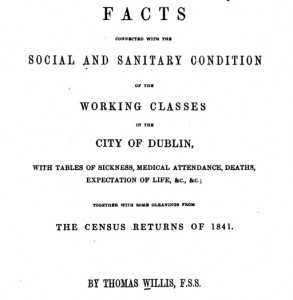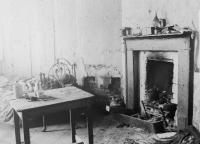Surveys of Dublin, II: An anatomy of St. Michan’s, 1845
Published in 18th-19th Century Social Perspectives, Blogging Irish History, Uncategorized
 Thomas Willis was a Dublin apothecary who was involved in various charitable activities throughout his life, such as the foundation of the Society of St Vincent de Paul in Ireland. He was based in St Michan’s parish, just behind Ormond Quay and in 1845 he published a survey of the parish that examined it it in minute detail, in order to, as he put it himself, ‘my immediate object is to concentrate public opinion on the present condition of the labouring classes, with a view to its amelioration, by providing for them residences fit for human beings’.
Thomas Willis was a Dublin apothecary who was involved in various charitable activities throughout his life, such as the foundation of the Society of St Vincent de Paul in Ireland. He was based in St Michan’s parish, just behind Ormond Quay and in 1845 he published a survey of the parish that examined it it in minute detail, in order to, as he put it himself, ‘my immediate object is to concentrate public opinion on the present condition of the labouring classes, with a view to its amelioration, by providing for them residences fit for human beings’.
His occupation gave him an intimate knowledge of the parish, which in the 1841 census contained 22,793 inhabitants, making it one of the five most congested of Dublin’s 21 parishes. But in the 1830s and 1840s it had declined markedly; it was one of the worst areas affected by the 1832 cholera epidemic (a quarter of 6,000 cases in the city were recorded there). From a close reading of the 1841 census, Willis calculated ‘the enormous number of 23,197, or very near one half of the entire number of families, have the wretched and perstiferous accomodation of a single room’. Tenements were already widespread in Dublin by this time. The population of St Michan’s was regulary swollen by rural migrants, perhaps due to its proximity to traditional routes into the city from Co. Meath. Apart from the Jameson distillery, three breweries and three foundries, the nature of the area, containing as it did a large number of markets, meant that most employment within the parish of St Michan’s was of a casual nature (a microcosm of the city as a whole?).
Willis recorded an infant mortality rate in the parish of 22.15% in first year, rising to 73.61% by age twenty six. In other words, 7 out of 10 children born in the parish of St Michan’s were dead by the age of 25. His extensive description of the squalid tenements he encountered is worth quoting at length:
‘There are no gentry within the district, and the few professional men or mercantile traders whom interest may still compel to keep their offices here, have their residences in some more favoured localities, This parish, that within the last thirty years might boast of as large a proportion of professional and mercantile wealth as any in the metropolis, is now the refuge of reduced persons from other districts, and very many of the houses then occupied by respectable traders, are now in the possession of a class of men called ‘housejobbers’, who re-let them to poor tenants. These jobbers have no interest in the houses save their weekly rents; the houses, therefore, undergo no repair; the staircase, passages, &c, are all in a state of filth; the yards in the rear are so many depots of putrid animal and vegetable matter; and if a necessary be in any of them, it frequently is a source of further nuisance. The courts and back places are, if possible, still worse, and are quite unfit for the residence of human beings. They are almost all closed up at each end, and communicating with the street by a long narrow passage, usually the hall of the front house, and not more than three or three and a half feet wide. Pipewater, lime washing, dust bin, privy – these are things almost unknown. The stench and disgusting filth of these places are inconceivable, unless to those whose harrowing duty obliges them to witness such scenes of wretchedness.
In some rooms in these situations it is not an infrequent occurrence to see above a dozen human beings crowded into a space not fifteen feet square. Within this space the food of these wretched beings, such as it is, must be prepared; within this space they must eat and drink; men, women and children must strip, dress, sleep. In cases of illness the calls of nature must be relieved, and when death releases one of the inmates the corpse must of necessity remain for days within the room. Let it not be supposed I have selected some solitary spot for this description: no, I am speaking of an entire district, and state facts incontrovertible. I indulge in no theories as to the causes which produce this state of things, but I may state the results. They are – that every cause that can contribute to general contagion exists here in full vigour, and that disease, in every aggravated form, with all its train of desolating misery, is rarely absent’.
Church St was at the heart of the parish of St Michan’s, and the collapse of two tenement houses there in September 1913 prompted an extensive inquiry into Dublin’s slum poverty. It confirmed what Willis had observed: that tenements were in evidence from circa 1840, when there were 353 in the city. This increased to 1,682 during the famine, thence to 5,995 in 1850, ‘some of which are still in use as tenement houses’. By 1880 there were 117,000 people living in 9,760 tenements. And the 1913 inquiry calculated that Dublin’s 5,322 tenement houses were still the homes of 87,305 people. Had Thomas Willis lived to survey his parish again in the second decade of the twentieth century, it may well have seemed all too familiar.
Further reading:
David Dickson (ed), The Hidden Dublin: The Social and Sanitary condition of Dublin’s Working Classes in 1845 described by Thomas Willis (Dublin, 2002).
The full text can be accessed via Google Books here.
To read Christiaan Corlett’s article on the Church St disaster, from our March/April 2009 issue, click here.

















